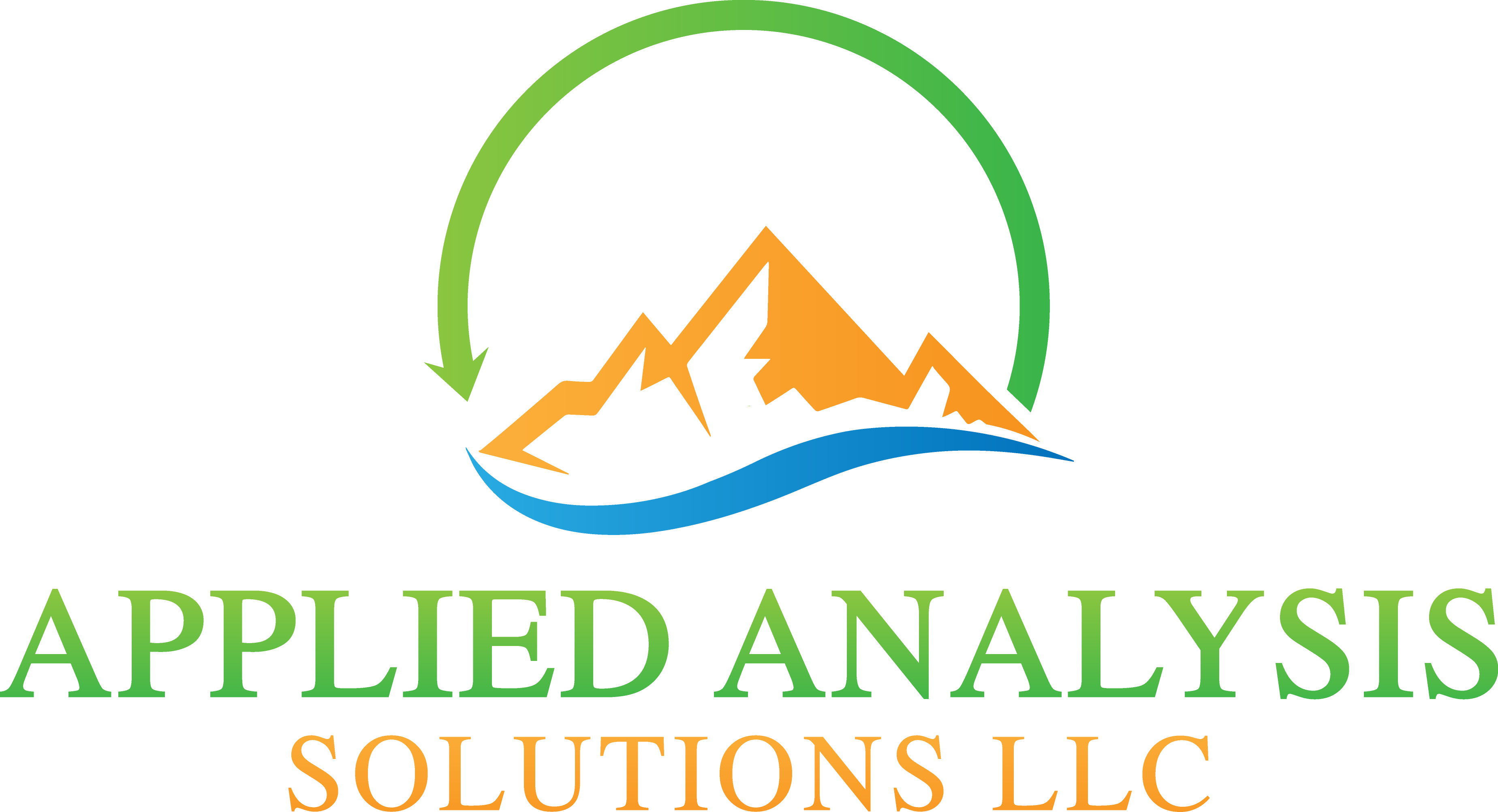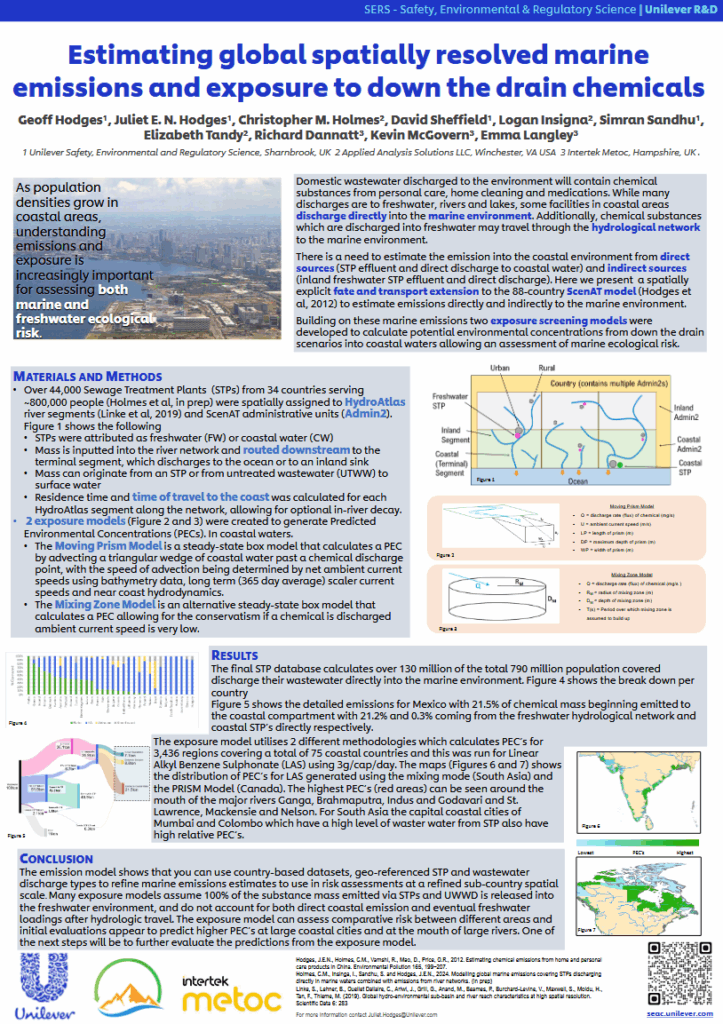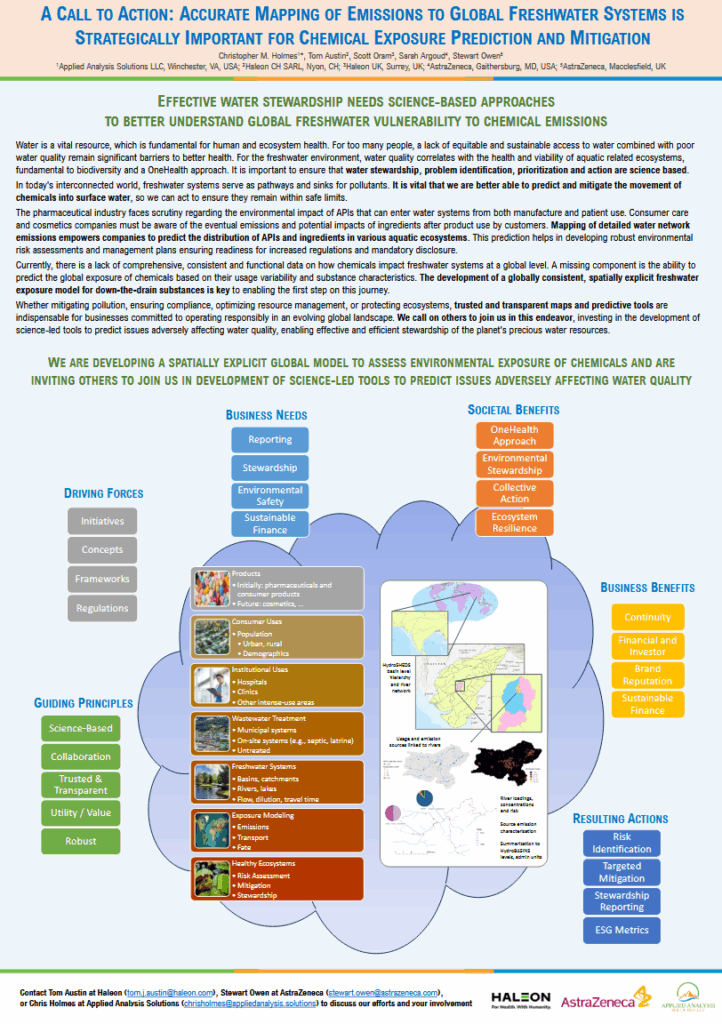2025
Hodges, G. (Unilever Safety, Environmental & Regulatory Science); Hodges, J. (Unilever Safety, Environmental & Regulatory Science); Holmes, C.M. (Applied Analysis Solutions, LLC); Sheffield, D. (Unilever Safety, Environmental & Regulatory Science); Insinga, L. (Applied Analysis Solutions, LLC); Sandha, S. (Unilever Safety, Environmental & Regulatory Science); Tandy, E. (Applied Analysis Solutions, LLC); Dannatt, R. (Intertek Metoc); McGovern, K. (Intertek Metoc); Langley, E. (Intertek Metoc)
Estimating global spatially resolved marine emissions and exposure to down the drain chemicals Presentation
05.11.2025.
Abstract | Links | Tags: 2025, Poster, SETAC Europe
@misc{EU25Marine,
title = {Estimating global spatially resolved marine emissions and exposure to down the drain chemicals},
author = {Hodges, G. (Unilever Safety, Environmental & Regulatory Science) and Hodges, J. (Unilever Safety, Environmental & Regulatory Science) and Holmes, C.M. (Applied Analysis Solutions, LLC) and Sheffield, D. (Unilever Safety, Environmental & Regulatory Science) and Insinga, L. (Applied Analysis Solutions, LLC) and Sandha, S. (Unilever Safety, Environmental & Regulatory Science) and Tandy, E. (Applied Analysis Solutions, LLC) and Dannatt, R. (Intertek Metoc) and McGovern, K. (Intertek Metoc) and Langley, E. (Intertek Metoc)},
url = {https://appliedanalysis.solutions/wp-content/uploads/2025/05/SETAC-EU-202S-Marine-Modelling.pdf, View Poster},
year = {2025},
date = {2025-05-11},
urldate = {2025-05-11},
abstract = {Domestic wastewater discharged to the environment may contain chemical substances that are the result of human activity. While many discharges are to freshwater rivers and lakes, some facilities in coastal areas discharge directly into the marine environment. however many down-the-drain exposure models assume 100% of the chemical mass discharged from STPs or untreated populations is released into the freshwater environment A dataset was developed to understand what fraction of the population in coastal areas are served by STPs that discharge directly to a marine environment. Information on STP location, population served, and effluent flow were collected for 44,000 STPs across 34 countries serving almost 800 million people
Chemical substances are also discharged into freshwater which then may travel through the hydrological network to the marine environment. Hydrologic travel distance/time for each inland STP as well as untreated mass was developed along with estimated aquatic half-lives, to estimate discharges into rivers moving to coastal waters. The developed emission model is a mass balance model.
The third phase of the study developed two exposure models for 3436 regions covering 75 coastal countries to generate Predicted Environmental Concentrations (PEC s). The Moving Prism Model is a steady-state box model that calculates a PEC by advecting a triangular wedge of coastal water past a chemical discharge point, with the speed of advection being determined by net ambient current speeds using bathymetry data, long term (365-day average) scaler current speeds and near coast hydrodynamics. The Mixing Zone Model is an alternative steady-state box model that calculates a PEC should a chemical be discharged into still water (i.e. with no ambient current speed). Some initial comparisons to monitoring data show good agreement.
This work shows that it is possible to use country-based datasets including geo-referenced STP and wastewater discharge types to refine emissions estimates for use in environmental exposure models and risk assessments at a refined sub-country spatial scale.
The exposure model provides a screening level, globally-consistent approach for assessing the potential impact of down-the-drain chemicals on the marine environment. These models generate estimates of Predicted Environmental Concentration and represent an intermediate level between generic, multi-media models and detailed, data hungry process-based models.},
keywords = {2025, Poster, SETAC Europe},
pubstate = {published},
tppubtype = {presentation}
}
Chemical substances are also discharged into freshwater which then may travel through the hydrological network to the marine environment. Hydrologic travel distance/time for each inland STP as well as untreated mass was developed along with estimated aquatic half-lives, to estimate discharges into rivers moving to coastal waters. The developed emission model is a mass balance model.
The third phase of the study developed two exposure models for 3436 regions covering 75 coastal countries to generate Predicted Environmental Concentrations (PEC s). The Moving Prism Model is a steady-state box model that calculates a PEC by advecting a triangular wedge of coastal water past a chemical discharge point, with the speed of advection being determined by net ambient current speeds using bathymetry data, long term (365-day average) scaler current speeds and near coast hydrodynamics. The Mixing Zone Model is an alternative steady-state box model that calculates a PEC should a chemical be discharged into still water (i.e. with no ambient current speed). Some initial comparisons to monitoring data show good agreement.
This work shows that it is possible to use country-based datasets including geo-referenced STP and wastewater discharge types to refine emissions estimates for use in environmental exposure models and risk assessments at a refined sub-country spatial scale.
The exposure model provides a screening level, globally-consistent approach for assessing the potential impact of down-the-drain chemicals on the marine environment. These models generate estimates of Predicted Environmental Concentration and represent an intermediate level between generic, multi-media models and detailed, data hungry process-based models.
Holmes, C.E. (Applied Analysis Solutions, LLC); Schad, T. (Bayer AG, Crop Science Division); Bub, S. (Rheinland‐Pfälzische Technische Universität); Holmes, C.M. (Applied Analysis Solutions, LLC)
05.11.2025.
Abstract | Links | Tags: 2025, Poster, SETAC Europe
@misc{EU25CropProtection,
title = {xCropProtection: a Spatiotemporal Component to Simulate Prospective and Retrospective PPP Applications in Real World Landscapes},
author = {Holmes, C.E. (Applied Analysis Solutions, LLC) and Schad, T. (Bayer AG, Crop Science Division) and Bub, S. (Rheinland‐Pfälzische Technische Universität) and Holmes, C.M. (Applied Analysis Solutions, LLC)},
url = {https://appliedanalysis.solutions/wp-content/uploads/2025/05/SETAC-EU-2025-xCropProtection.pdf, View Poster},
year = {2025},
date = {2025-05-11},
urldate = {2025-05-11},
abstract = {There is currently both scientific and public discussion about chemical crop protection uses and trends. There seems to be consensus that chemical crop protection should be generally reduced or used more targeted in the future. In parallel there are requests for more realistic and holistic risk assessments of pesticides. We developed a spatiotemporally explicit component for simulating plant protection product (PPP) applications in landscapes which integrates with a larger spatiotemporal landscape model (xLandscape). This component, xCropProtection, can simulate applications at a field scale given PPP application information including target crops, spatial landscape information, and application periods. The result of running this component is a multidimensional dataset of PPP applications specific to individual fields and time steps. xCropProtection is parameterized with XML files, a file type used to store data in a hierarchical format well suited for sending and storing data. These XML files contain target crop types, PPP (or active substance) names, tank mixes, application rates (as a probability distribution function or a static value), probabilistic application windows, and mitigation measures for reducing exposure. xCropProtection functions both prospectively and retrospectively where input files can come from GAP tables in established risk assessment, can represent recommendations from plant protection advisory services, records from monitoring and field studies, or can be derived from market share grower surveys. xCropProtection is one component in the larger xLandscape framework that provides the simulation of more realistic pesticide applications for exposure, effect and risk assessments. },
keywords = {2025, Poster, SETAC Europe},
pubstate = {published},
tppubtype = {presentation}
}
Holmes, C.M. (Applied Analysis Solutions, LLC); Austin, T. (Haleon CH SARL); Oram, S. (Haleon UK); Argoud, S. (AstraZeneca); Owen, S. (AstraZeneca)
05.11.2025.
Abstract | Links | Tags: 2025, Poster, SETAC Europe
@misc{EU25CallToAction,
title = {A Call to Action: Accurate Mapping of Emissions to Global Freshwater Systems is Strategically Important for Chemical Exposure Prediction and Mitigation},
author = {Holmes, C.M. (Applied Analysis Solutions, LLC) and Austin, T. (Haleon CH SARL) and Oram, S. (Haleon UK) and Argoud, S. (AstraZeneca) and Owen, S. (AstraZeneca)},
url = {https://appliedanalysis.solutions/wp-content/uploads/2025/05/SETAC-EU-2025-Global-Model.pdf, View Poster},
year = {2025},
date = {2025-05-11},
urldate = {2025-05-11},
abstract = {Water is a vital resource, which is fundamental for human and ecosystem health. For too many people, a lack of equitable and sustainable access to water combined with poor water quality remain significant barriers to better health. For the freshwater environment, water quality correlates with the health and viability of aquatic related ecosystems, fundamental to biodiversity and a OneHealth approach. It is important to ensure that water stewardship, problem identification, prioritization and action are science based. In today's interconnected world, freshwater systems serve as pathways and sinks for pollutants. It is vital that we are better able to predict and mitigate the movement of chemicals into surface water, so we can act to ensure they remain within safe limits. The pharmaceutical industry faces scrutiny regarding the environmental impact of APIs that can enter water systems from both manufacture and patient use. Consumer care and cosmetics companies must be aware of the eventual emissions and potential impacts of ingredients after product use by customers. Mapping of detailed water network emissions empowers companies to predict the distribution of APIs and ingredients in various aquatic ecosystems. This prediction helps in developing robust environmental risk assessments and management plans ensuring readiness for increased regulations and mandatory disclosure. Currently, there is a lack of comprehensive, consistent and functional data on how chemicals impact freshwater systems at a global level. A missing component is the ability to predict the global exposure of chemicals based on their usage variability and substance characteristics. The development of a globally consistent, spatially explicit freshwater exposure model for down-the-drain substances is key to enabling the first step on this journey. Whether mitigating pollution, ensuring compliance, optimizing resource management, or protecting ecosystems, trusted and transparent maps and predictive tools are indispensable for businesses committed to operating responsibly in an evolving global landscape. We call on others to join us in this endeavor, investing in the development of science-led tools to predict issues adversely affecting water quality, enabling effective and efficient stewardship of the planet's precious water resources.},
keywords = {2025, Poster, SETAC Europe},
pubstate = {published},
tppubtype = {presentation}
}



